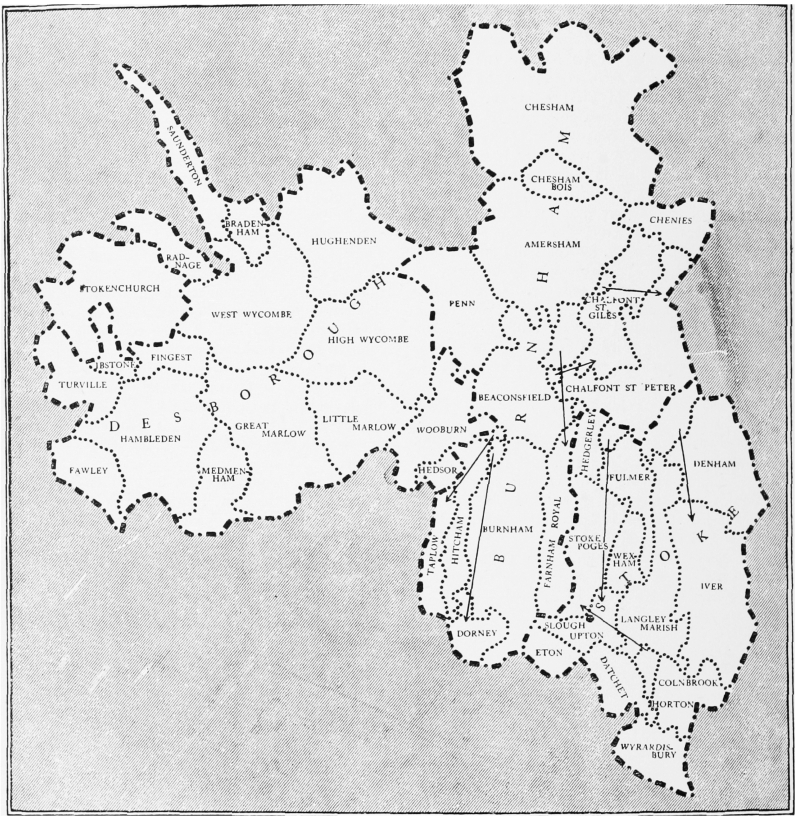A History of the County of Buckingham: Volume 3. Originally published by Victoria County History, London, 1925.
This free content was digitised by double rekeying. All rights reserved.
'The three hundreds of Chiltern: Introduction and map', in A History of the County of Buckingham: Volume 3, ed. William Page (London, 1925), British History Online https://prod.british-history.ac.uk/vch/bucks/vol3/pp32-34 [accessed 23 April 2025].
'The three hundreds of Chiltern: Introduction and map', in A History of the County of Buckingham: Volume 3. Edited by William Page (London, 1925), British History Online, accessed April 23, 2025, https://prod.british-history.ac.uk/vch/bucks/vol3/pp32-34.
"The three hundreds of Chiltern: Introduction and map". A History of the County of Buckingham: Volume 3. Ed. William Page (London, 1925), British History Online. Web. 23 April 2025. https://prod.british-history.ac.uk/vch/bucks/vol3/pp32-34.
In this section
THE THREE HUNDREDS OF CHILTERN

Index Map to the Three Hundreds of Chiltern
THE HUNDRED OF DESBOROUGH (fn. 1)
CONTAINING THE PARISHES OF
THE HUNDRED OF BURNHAM
CONTAINING THE PARISHES OF
| AMERSHAM | CHALFONT ST. PETER | FARNHAM ROYAL with HEDGERLEY DEAN and SEER GREEN |
| BEACONSFIELD | CHENIES | HITCHAM |
| BURNHAM with LOWER BOVENEY | CHESHAM | PENN |
| CHESHAM BOIS | TAPLOW | |
| CHALFONT ST. GILES | DORNEY |
THE HUNDRED OF STOKE
CONTAINING THE PARISHES OF
| COLNBROOK | HEDGERLEY | STOKE POGES |
| DATCHET | HORTON | UPTON-CUM-CHALVEY |
| DENHAM | IVER | WEXHAM |
| ETON | LANGLEY MARISH | WYRARDISBURY (fn. 2) |
| FULMER | SLOUGH |
Even as early as the 11th century the three hundreds of Desborough, Burnham and Stoke seem to have been grouped together, (fn. 3) and by the middle of the 13th century were known as the three Chiltern Hundreds. (fn. 4) In 1086 Desborough Hundred was assessed at 122 hides 2½ virgates, Burnham at 100 hides (fn. 5) and Stoke at 112 hides 2 virgates. (fn. 6) The parishes of Beaconsfield, Chalvey, Chenies, Fingest, Fulmer, Hedgerley, Hedsor, Langley Marish, Penn, Radnage and Wexham are not named in the Domesday Survey. The hamlets of Boveney in Burnham, Bockmer in Medmenham, Ditton, a detached part of Stoke Poges, Tylers [Green] in Penn and Lyde in Wooburn have separate entries, and Upton was included under the king's lands. Eton has been transferred from Burnham to Stoke Hundred and Farnham Royal from Stoke to Burnham Hundred. Coleshill, a detached part of Hertfordshire, is now included in Burnham Hundred. Stokenchurch, which is locally in Desborough Hundred, was transferred from Oxfordshire to Buckinghamshire in 1896.
As early as the 13th century, if not before, the Chiltern Hundreds were appurtenant to the Crown and were administered as a royal bailiwick. (fn. 7) In 1653 they yielded yearly in hidage £28 5s. 1d. and in other payments £5 10s. (fn. 8) In 1824 the hundreds of Desborough and Stoke appear to have been leased to Francis Godolphin Osborne, ancestor of the Duke of Leeds. (fn. 9)
The office of Steward of the Chiltern Hundreds has long been a purely nominal one. The passing of the Place Act in 1742 (fn. 10) made it possible to use this appointment for Parliamentary purposes as a pretext for enabling members of the House of Commons to resign their seats. This has been done often, several times in one session, since 1750, when John Peel resigned his seat in this way. (fn. 11) Particulars about applications by members for this office and the form used by the Chancellor of the Exchequer in making the appointment were printed by the House of Commons in 1846. (fn. 12)
By the middle of the 13th century there was a second royal bailiwick of Chiltern Hundreds, comprising the Oxfordshire hundreds of Binfield, Langtree, Lewknor, Pirton and half the hundred of Ewelme, distinguished as the Four and a half Chiltern Hundreds. (fn. 13)
Accounts made in connexion with their administration are extant, dating between 1270 and 1485, (fn. 14) but the last reference to them as the Chiltern Hundreds that has been found occurs in 1521. (fn. 15)